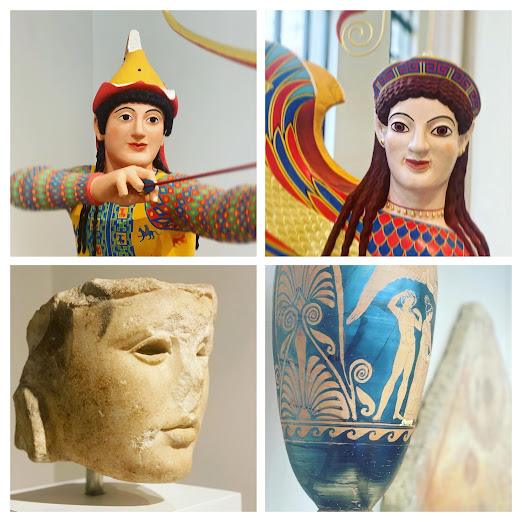Hi, I’m Greig — welcome! Here you’ll find sharp writing, creative ideas, and standout resources for teaching, thinking, making, and dreaming in the middle and high school ELA and Humanities classroom (Grades 6–12).
10.3.24
Language Meets Art: Exploring 'Amor' and 'Caritas' in Augustus-Saint-Gaudens’ Work at The Met 🌟🖼️
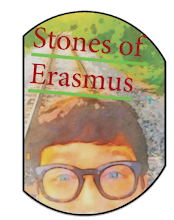 I am an educator and a writer. I was born in Louisiana and I now live in the Big Apple. My heart beats to the rhythm of "Ain't No Place to Pee on Mardi Gras Day". My style is of the hot sauce variety. I love philosophy sprinkles and a hot cup of café au lait.
I am an educator and a writer. I was born in Louisiana and I now live in the Big Apple. My heart beats to the rhythm of "Ain't No Place to Pee on Mardi Gras Day". My style is of the hot sauce variety. I love philosophy sprinkles and a hot cup of café au lait.
31.1.24
Rediscovering "Bélizaire and the Frey Children": A Tale of Resilience in Southern Art
Hey, y’all. I’m in the Metropolitan Museum of Art in the American Wing. Y’all — it’s a moment of rediscovery for this New Orleanian! I’m standing before the once-lost-now-found “Bélizaire and the Frey Children,” a significant artwork that was hidden in the New Orleans Museum of Art’s storage for ages.
 I am an educator and a writer. I was born in Louisiana and I now live in the Big Apple. My heart beats to the rhythm of "Ain't No Place to Pee on Mardi Gras Day". My style is of the hot sauce variety. I love philosophy sprinkles and a hot cup of café au lait.
I am an educator and a writer. I was born in Louisiana and I now live in the Big Apple. My heart beats to the rhythm of "Ain't No Place to Pee on Mardi Gras Day". My style is of the hot sauce variety. I love philosophy sprinkles and a hot cup of café au lait.
20.12.23
Medieval Majesty: Exploring the Intricacies of 11th Century Ivory Art at the Metropolitan Museum of Art
 I am an educator and a writer. I was born in Louisiana and I now live in the Big Apple. My heart beats to the rhythm of "Ain't No Place to Pee on Mardi Gras Day". My style is of the hot sauce variety. I love philosophy sprinkles and a hot cup of café au lait.
I am an educator and a writer. I was born in Louisiana and I now live in the Big Apple. My heart beats to the rhythm of "Ain't No Place to Pee on Mardi Gras Day". My style is of the hot sauce variety. I love philosophy sprinkles and a hot cup of café au lait.
🛡️ A Journey Through History at The Met’s Arms and Armor Gallery 🏰
 I am an educator and a writer. I was born in Louisiana and I now live in the Big Apple. My heart beats to the rhythm of "Ain't No Place to Pee on Mardi Gras Day". My style is of the hot sauce variety. I love philosophy sprinkles and a hot cup of café au lait.
I am an educator and a writer. I was born in Louisiana and I now live in the Big Apple. My heart beats to the rhythm of "Ain't No Place to Pee on Mardi Gras Day". My style is of the hot sauce variety. I love philosophy sprinkles and a hot cup of café au lait.
29.11.23
Exploring Ancient Herms: A Visit to the Met Museum and Discovering Timeless Symbols
Join me on a journey through the Met Museum, exploring ancient herms and uncovering the enduring influence of these fascinating artifacts.
 I am an educator and a writer. I was born in Louisiana and I now live in the Big Apple. My heart beats to the rhythm of "Ain't No Place to Pee on Mardi Gras Day". My style is of the hot sauce variety. I love philosophy sprinkles and a hot cup of café au lait.
I am an educator and a writer. I was born in Louisiana and I now live in the Big Apple. My heart beats to the rhythm of "Ain't No Place to Pee on Mardi Gras Day". My style is of the hot sauce variety. I love philosophy sprinkles and a hot cup of café au lait.
18.7.23
Admiring Saint Catherine of Alexandria: A 16th Century Italian Sculpture at the Metropolitan Museum of Art
 I am an educator and a writer. I was born in Louisiana and I now live in the Big Apple. My heart beats to the rhythm of "Ain't No Place to Pee on Mardi Gras Day". My style is of the hot sauce variety. I love philosophy sprinkles and a hot cup of café au lait.
I am an educator and a writer. I was born in Louisiana and I now live in the Big Apple. My heart beats to the rhythm of "Ain't No Place to Pee on Mardi Gras Day". My style is of the hot sauce variety. I love philosophy sprinkles and a hot cup of café au lait.
17.7.23
Teaching the Mythological Marvel: Perseus and Medusa - A Tale of Heroism, Divine Intervention, and Greek Mythology for the Middle and High School Classroom
 |
| The Argive hero Perseus pervades myth, art, and literature. |
Unravel the captivating tale of Perseus, the valiant son of Zeus, and his heroic quest to slay the mortal Gorgon, Medusa. Discover the harrowing circumstances that led Perseus to undertake this perilous mission, from being locked in a chest as a child to seeking revenge against Polydectes, his mother's treacherous husband. Journey alongside Perseus as he ventures to the edge of the world in pursuit of his formidable foe.
 |
| Discover Mythology Resources from Stones of Erasmus |
 I am an educator and a writer. I was born in Louisiana and I now live in the Big Apple. My heart beats to the rhythm of "Ain't No Place to Pee on Mardi Gras Day". My style is of the hot sauce variety. I love philosophy sprinkles and a hot cup of café au lait.
I am an educator and a writer. I was born in Louisiana and I now live in the Big Apple. My heart beats to the rhythm of "Ain't No Place to Pee on Mardi Gras Day". My style is of the hot sauce variety. I love philosophy sprinkles and a hot cup of café au lait.
15.7.23
Unearthing Mysteries: An Encounter with Fortuna at The Metropolitan Museum of Art
I am standing amidst the breathtaking expanse of the Metropolitan Museum of Art in New York City. Amid the myriad of artifacts and art pieces, I find myself drawn to an object of particular intrigue. At first glance it may not command your immediate attention, but its narrative is as grand as any. It’s a captivating statuette hailing from the Byzantine era, bearing the likeness of the Roman goddess Fortuna—also known as Tyche.
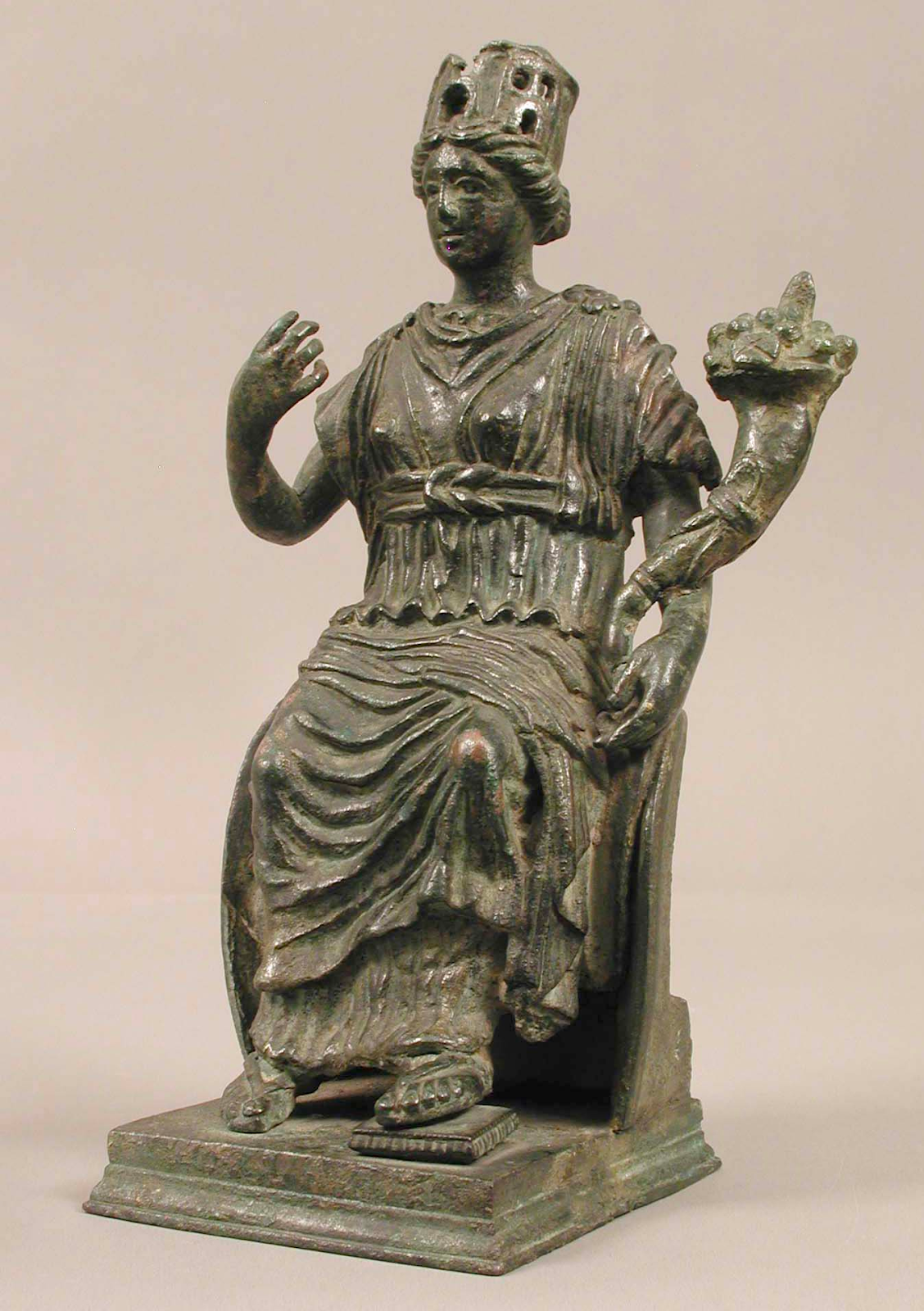
|
| Fortuna (Tyche), Late Roman or Byzantine, ca. 300–500 C.E. |
Fortuna’s sculptural headdress resembles a walled city, complete with gate and battlements—an emblem of civic power. In her hand she holds a cornucopia, the timeless sign of abundance. Together these details weave a story about the interplay of prosperity, urban life, and the capricious hand of fate. Far from being “just a cool little statuette,” this bronze is a compact lesson in how chance shapes civilizations.
 I am an educator and a writer. I was born in Louisiana and I now live in the Big Apple. My heart beats to the rhythm of "Ain't No Place to Pee on Mardi Gras Day". My style is of the hot sauce variety. I love philosophy sprinkles and a hot cup of café au lait.
I am an educator and a writer. I was born in Louisiana and I now live in the Big Apple. My heart beats to the rhythm of "Ain't No Place to Pee on Mardi Gras Day". My style is of the hot sauce variety. I love philosophy sprinkles and a hot cup of café au lait.
12.7.23
Resurrecting Adam: Tullio Lombardo's Masterpiece Restored
 I am an educator and a writer. I was born in Louisiana and I now live in the Big Apple. My heart beats to the rhythm of "Ain't No Place to Pee on Mardi Gras Day". My style is of the hot sauce variety. I love philosophy sprinkles and a hot cup of café au lait.
I am an educator and a writer. I was born in Louisiana and I now live in the Big Apple. My heart beats to the rhythm of "Ain't No Place to Pee on Mardi Gras Day". My style is of the hot sauce variety. I love philosophy sprinkles and a hot cup of café au lait.
Marveling at Tullio Lombardo's Young Warrior: A Journey into Late 15th Century Venetian Art
Tucked into a portion of the east side of Central Park in New York City, nestled among a myriad of remarkable artifacts at the Metropolitan Museum of Art, stands a profound example of late 15th-century Venetian art. This remarkable piece is a marble sculpture of a young warrior by Tullio Lombardo, a master of the Italian Renaissance from Venice. The immersive experience of admiring this piece face-to-face truly transcends the ordinary museum visit.
 I am an educator and a writer. I was born in Louisiana and I now live in the Big Apple. My heart beats to the rhythm of "Ain't No Place to Pee on Mardi Gras Day". My style is of the hot sauce variety. I love philosophy sprinkles and a hot cup of café au lait.
I am an educator and a writer. I was born in Louisiana and I now live in the Big Apple. My heart beats to the rhythm of "Ain't No Place to Pee on Mardi Gras Day". My style is of the hot sauce variety. I love philosophy sprinkles and a hot cup of café au lait.
7.7.23
Exploring Artistic Marvels: Unveiling the Spinario at the Metropolitan Museum of Art
 I am an educator and a writer. I was born in Louisiana and I now live in the Big Apple. My heart beats to the rhythm of "Ain't No Place to Pee on Mardi Gras Day". My style is of the hot sauce variety. I love philosophy sprinkles and a hot cup of café au lait.
I am an educator and a writer. I was born in Louisiana and I now live in the Big Apple. My heart beats to the rhythm of "Ain't No Place to Pee on Mardi Gras Day". My style is of the hot sauce variety. I love philosophy sprinkles and a hot cup of café au lait.
22.1.23
Celebrating the Lunar New Year of the Rabbit: On an Outing to the Metropolitan Museum of Art
 |
| Dragon Dancers from Long Island |
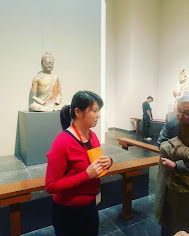 |
| A museum docent talks about a 16th-century Buddha sculpture from China. |
 I am an educator and a writer. I was born in Louisiana and I now live in the Big Apple. My heart beats to the rhythm of "Ain't No Place to Pee on Mardi Gras Day". My style is of the hot sauce variety. I love philosophy sprinkles and a hot cup of café au lait.
I am an educator and a writer. I was born in Louisiana and I now live in the Big Apple. My heart beats to the rhythm of "Ain't No Place to Pee on Mardi Gras Day". My style is of the hot sauce variety. I love philosophy sprinkles and a hot cup of café au lait.
14.7.22
Aesthetic Thursday: "You Got Color, Girl?" Chroma Exhibition at the Metropolitan Museum of Art
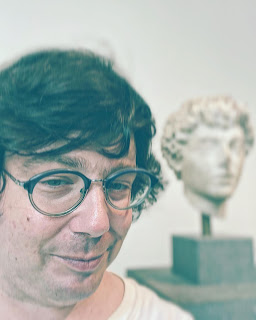 |
| Greig poses in front of a young Marcus Aurelius in the Ancient Greek and Roman wing of the Metropolitan Museum of Art in New York City. |
 |
| Marble head of the youthful Marcus Aurelius ca. C.E. 138. |
But go to a museum today, and you see staid marble and what appears to be a vast collection of grays, browns, and three-dimensional black and white photographs. But the pigments and paints decay. And the weathering of the seasons and the march of time have made most color drain away.
But the coloration is still there, in small traces — which the Chroma exhibition at the Metropolitan Museum of Art has attempted to recapture — to see ancient artworks in color again. Alas, you won’t see the now lost statue of Zeus at Olympia, but you will see that same artist’s head of Athena, which at one time had ebony eyes. I especially liked the bronze warriors. And the Sphinx in color was fantastic.
If you have a moment and you are in New York — take a moment and experience these reconstructions done by Prof. Dr. V. Brinkmann & Dr. U. Koch-Brinkmann. @metmuseum @metgreekandroman
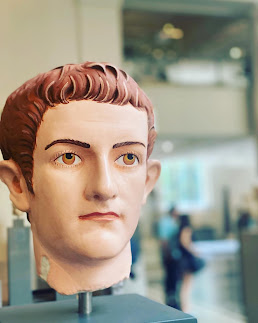 |
| Reconstruction of a marble portrait of the Emperor Gaius Julius Caesar Augustus Germanicus, known as Caligula, Variant B. |
 | ||||
| [1] Reconstruction the bronze statue from the Quirinal in Rome of the so-called Terme Rule. [2] Reconstruction of bronze Riace Warrior (mid-view detail). |
 I am an educator and a writer. I was born in Louisiana and I now live in the Big Apple. My heart beats to the rhythm of "Ain't No Place to Pee on Mardi Gras Day". My style is of the hot sauce variety. I love philosophy sprinkles and a hot cup of café au lait.
I am an educator and a writer. I was born in Louisiana and I now live in the Big Apple. My heart beats to the rhythm of "Ain't No Place to Pee on Mardi Gras Day". My style is of the hot sauce variety. I love philosophy sprinkles and a hot cup of café au lait.
14.1.21
Aesthetic Thursday: Poussin’s Poetic Painting "Blind Orion Searching for the Rising Sun" at the Metropolitan Museum of Art
 |
| Nicolas Poussin, French Les Andelys 1594-1665 Rom — "Blind Orion Searching for the Rising Sun," 1658 (oil on canvas). The Metropolitan Museum of Art, New York City. 24.45.1 |
The Metropolitan Museum of Art has recently renovated its European Paintings galleries. The skylights have been fixed and apparently more artwork has been hung on the walls. I like to wander the galleries without a goal in mind — however, I lie just a bit, here. Because I did have a goal in my wanderings — mainly to find the Met's Caravaggio's. But it's always the serendipitous finds that stick with me. And Poussin's "Blind Orion" caught my attention. I know nothing of Poussin — so my interpretation of the painting is more of a first blush. But I am a lover of myth and poetry — and this painting draws you into a mythological world. At first I thought the giant figure carrying a man on his shoulders was Saint Christopher — the legendary boatsman who carried the Christ child on his shoulder crossing a river. But that is not the subject of this painting. It's a depiction of the blind giant Orion, who carries his guide Cedalion, as they look for the rising sun. The museum placard indicates that Diana, the moon goddess, who appears a diaphanous blue, stands watching in the clouds. It's a magical story; obviously one fit for myth — but the scene resonates with me because I think of myself as somewhat of a wanderer. And Orion is also the name of one of my favorite constellations. So it is befitting. Here's to searching. For the healing sun.
 I am an educator and a writer. I was born in Louisiana and I now live in the Big Apple. My heart beats to the rhythm of "Ain't No Place to Pee on Mardi Gras Day". My style is of the hot sauce variety. I love philosophy sprinkles and a hot cup of café au lait.
I am an educator and a writer. I was born in Louisiana and I now live in the Big Apple. My heart beats to the rhythm of "Ain't No Place to Pee on Mardi Gras Day". My style is of the hot sauce variety. I love philosophy sprinkles and a hot cup of café au lait.
7.2.13
Aesthetic Thursday: Bradley Rubenstein
 |
| Bradley Rubenstein, Unititled (Girl with Puppy Dog Eyes), 1996 |
At first I see this image as a brash conceit. All art is a conceit - right? - but this image forces me to see the conceit, to see that it's a mash-up. Maybe I am troubled because I have this ontological conviction that a photograph tells me something about reality. Maybe so. But maybe the reality that I am seeing is not so conceitful as I first think. What is going on here? Through the use of digital manipulation puppy dog eyes are inserted into a girl's eyes.
I Like Images That Make Me Re-Think What I am Seeing
I like images that ask me to question the image, to make me consider its mode of production. How did the artist do this? What was his method? I suppose this is Rubenstein's point. By making me aware of how this particular image was produced I am struck by another possibility - the genetic manipulation that would be required to produce a real girl born with puppy dog eyes. Rubenstein is playing with conceit to alert us to the biogenetic possibility that what we see as conceit could become a reality. What if someone decided that little girls and little puppies are a desirable combination? Is what we see in the art an image of a possible future?
Two Paragons of Cuteness: Kids and Puppies
On the placard, a museum curator has written this, "Merging two paragons of cuteness—kids and puppies—into unsettling hybrids, the artist offers an eerie forewarning of the transgressive potential of genetic manipulation." Where is the transgression? In imagining such mutations? Is the point that the degrees that separate the photoshop touch-up from the biogenetic not that far apart? Perhaps. Maybe the most unsettling aspect of Rubenstein's photographs is that he is telling us we have already arrived at this stage - we are just waiting for the biotechnology to catch up. I think I need to go watch Bladerunner and re-read Kazuo Ishiguro's When We Were Orphans.
 I am an educator and a writer. I was born in Louisiana and I now live in the Big Apple. My heart beats to the rhythm of "Ain't No Place to Pee on Mardi Gras Day". My style is of the hot sauce variety. I love philosophy sprinkles and a hot cup of café au lait.
I am an educator and a writer. I was born in Louisiana and I now live in the Big Apple. My heart beats to the rhythm of "Ain't No Place to Pee on Mardi Gras Day". My style is of the hot sauce variety. I love philosophy sprinkles and a hot cup of café au lait.
31.1.13
Aesthetic Thursday: Matthew Jensen's "49 States"
 |
| Matthew Jensen, The 49 States, 2008-9
Google Streetview in Art
I am addicted to Google Street View. I am going to Philadelphia this weekend and I have already seen on Street View what the hotel will look like, what the front of a restaurant I want to have lunch at looks like — all as if I will have already "done" the trip before I even go. Someone else has already been there. Someone has already snapped a photograph. There is nothing new under the sun. But I like what Matthew Jensen has done in the Metropolitan Museum of Art display of his work — he has taken a collage of images from Google Street View and organized them alphabetically according to State (e.g., the fifty states of the United States). Jensen's Work at the Met Reminds Me of the Iconic American Road Trip Seeing Jensen's work at the Met, as part of an exhibit on contemporary photography, I think of travel, the association Americans have with the road trip and snapping pictures. What is a road trip without a camera? Now that we have Google to take our snapshots for us maybe the camera is dead on the road. *sad face*. The images Jensen has collected are absent individuals but it seems easy enough to insert a human being into each State's slot. Look, there is me in New York. There is me in Connecticut. I look at my home state of Louisiana and compare it to Wisconsin. They both seem the same — and taken as a whole the image captures a unity of sorts, the kind of unity I get when traveling on the interstate where every exit is the same as the ones that came before it and all the ones ahead will look the same and so on. Is this a new American flag? Maybe so. Stray Observations:
|
 I am an educator and a writer. I was born in Louisiana and I now live in the Big Apple. My heart beats to the rhythm of "Ain't No Place to Pee on Mardi Gras Day". My style is of the hot sauce variety. I love philosophy sprinkles and a hot cup of café au lait.
I am an educator and a writer. I was born in Louisiana and I now live in the Big Apple. My heart beats to the rhythm of "Ain't No Place to Pee on Mardi Gras Day". My style is of the hot sauce variety. I love philosophy sprinkles and a hot cup of café au lait.
29.7.11
Aesthetic Thursday: Max Beckmann, Beginning
 |
| "Beginning" Max Beckmann, 1949, oil on canvas, The Metropolitan Museum of Art |
The piece "Beginning" is a triptych which means it is a single work composed of three panels. Triptychs were originally intended for religious art. Since the work is composed of three separate panels, once installed in a church or home, the priest could open or close the panel depending on the day of observance. Beckmann chooses the traditional triptych style, not for religious purposes but to depict pivotal events in a boy's adolescent development.
The Central Panel
The central panel depicts a boy on a white horse, a woman wearing blue stockings lying on a divan (smoking a hookah?), a cat hangs on the ceiling (reminds me of Puss in Boots).
Left Panel
An organ grinder, an angel, a boy with a crown.
Right Panel
Boys with laconic gazes, a teacher disciplines a pupil, a boy displays his pornographic magazine to other students.
 I am an educator and a writer. I was born in Louisiana and I now live in the Big Apple. My heart beats to the rhythm of "Ain't No Place to Pee on Mardi Gras Day". My style is of the hot sauce variety. I love philosophy sprinkles and a hot cup of café au lait.
I am an educator and a writer. I was born in Louisiana and I now live in the Big Apple. My heart beats to the rhythm of "Ain't No Place to Pee on Mardi Gras Day". My style is of the hot sauce variety. I love philosophy sprinkles and a hot cup of café au lait.
23.7.11
Thomas J. Watson Library, Metropolitan Museum of Art
 |
| Interior, The Watson Library, image: the Metropolitan Museum of Art |
Further Information:
Where: The Metropolitan Museum of Art, 1000 5th Avenue, New York, NY 10028, First Floor
Public Hours: Weekdays: Monday–Friday 10 am–5:15 pm; book retrieval until 3:30 pm.
Contact: Watson Library Contact Form
Telephone: 212-650-2312
 I am an educator and a writer. I was born in Louisiana and I now live in the Big Apple. My heart beats to the rhythm of "Ain't No Place to Pee on Mardi Gras Day". My style is of the hot sauce variety. I love philosophy sprinkles and a hot cup of café au lait.
I am an educator and a writer. I was born in Louisiana and I now live in the Big Apple. My heart beats to the rhythm of "Ain't No Place to Pee on Mardi Gras Day". My style is of the hot sauce variety. I love philosophy sprinkles and a hot cup of café au lait.
23.6.11
Aesthetic Thursday: Alexander McQueen at the Metropolitan Museum of Art
In this blog post, I write about the newest fashion exhibition at the Metropolitan Museum of Art - Alexander McQueen - Savage Beauty.
 |
The Dialectic of Beauty, Alexander McQueen Struggles with Deconstructive Aesthetics
If you are in New York City between now and August 7, 2011, check out the "Alexander McQueen: Savage Beauty Exhibit."
The exhibit boasts an ample retrospective on the deceased fashion designer's life works, dating back from his seminal graduate student collection inspired by Jack the Ripper to his most recent posthumous collection.
Jellyfish designs, a macabre mixture of duck feathers and leather masks, spray-on dresses, and kinky "bumster" design pants, the McQueen exhibit is a touching tribute to a man who certainly obsessed over dichotomies, divergences, and the question of the beautiful.
|
 I am an educator and a writer. I was born in Louisiana and I now live in the Big Apple. My heart beats to the rhythm of "Ain't No Place to Pee on Mardi Gras Day". My style is of the hot sauce variety. I love philosophy sprinkles and a hot cup of café au lait.
I am an educator and a writer. I was born in Louisiana and I now live in the Big Apple. My heart beats to the rhythm of "Ain't No Place to Pee on Mardi Gras Day". My style is of the hot sauce variety. I love philosophy sprinkles and a hot cup of café au lait.
24.2.11
Aesthetic Thursdays: Perseus with the Head of Medusa
 | |
|
 |
| The Face of Perseus |
 |
| Detail - The Head of Medusa, Metropolitan Museum |
 I am an educator and a writer. I was born in Louisiana and I now live in the Big Apple. My heart beats to the rhythm of "Ain't No Place to Pee on Mardi Gras Day". My style is of the hot sauce variety. I love philosophy sprinkles and a hot cup of café au lait.
I am an educator and a writer. I was born in Louisiana and I now live in the Big Apple. My heart beats to the rhythm of "Ain't No Place to Pee on Mardi Gras Day". My style is of the hot sauce variety. I love philosophy sprinkles and a hot cup of café au lait.
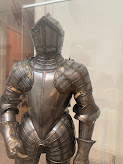 .
. 






